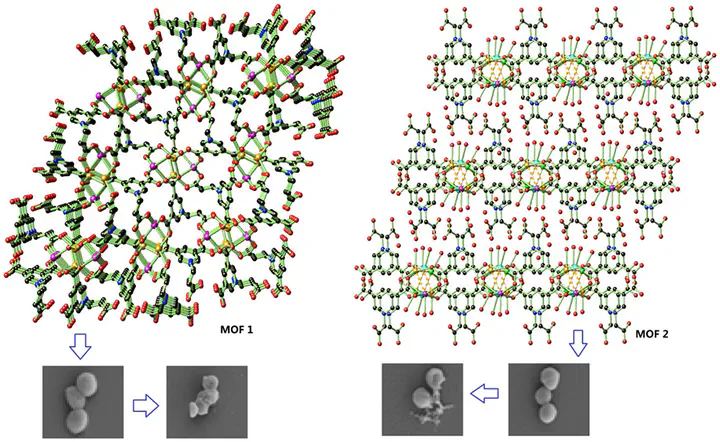The Synthesis of bio-nano material: MOFs(Metal-Organic Frameworks)
 Structure of the MOFs we synthesized
Structure of the MOFs we synthesized
Pathogenic bacteria are responsible for causing grave concerns regarding human health due to the prevalence of infectious diseases. In the realm of clinical bacterial infections, antibiotics serve as the simplest and most efficacious drugs. Nonetheless, widespread evidence indicates that the excessive and inappropriate utilization of antibiotics has given rise to drug resistance and bacterial imbalance. In particular, the emergence of robust drug resistance in bacteria, commonly known as “super bacteria,” has evolved into a pressing matter. As a result, the need to swiftly develop potent and eco-friendly antibacterial substances has become paramount and demands immediate attention.
Silver-based inorganic and organic–inorganic composite materials have been widely exploited to show strong inhibitory or bactericidal effects on microbes. They have been increasingly used in many normal commodities and medical equipment. Lately, some pertinent metal–organic frameworks (MOFs) have also appeared as novel antibacterial agents that exhibit some unique traits including a wide antibacterial spectrum, long periods of persistence, and promising efficacy. Compared to conventional drugs, MOF-based antibacterial agents have many advantages. The active sites of metal ions in the MOFs are effectively wrapped by the organic ligands and evenly distributed across the overall material, enabling a sustained release of metal ions to avoid the toxicity caused by a burst release of metal ions.
In this study, we expanded our investigation into the antibacterial properties of MOFs composed of quaternized carboxylate ligands in combination with Ag+ ions. Two distinct MOFs were successfully synthesized under gentle conditions: a three-dimensional (3D) MOF denoted as [Ag2(Cedcp)]n (designated as 1, with H3CedcpBr representing N-(carboxyethyl)-(3,5-dicarboxyl)-pyridinium bromide), and a two-dimensional (2D) MOF {[Ag4(Cmdcp)2(H2O)4]·4H2O}n (referred to as 2, where H3CmdcpBr signifies N-(carboxymethyl)-(3,5-dicarboxyl)-pyridinium bromide). Notably, MOFs 1 and 2 exhibited exceptional water stability and solubility, alongside potent antimicrobial activity, while also demonstrating favorable biocompatibility.
For more details, please click to download the pdf-version article provided above.